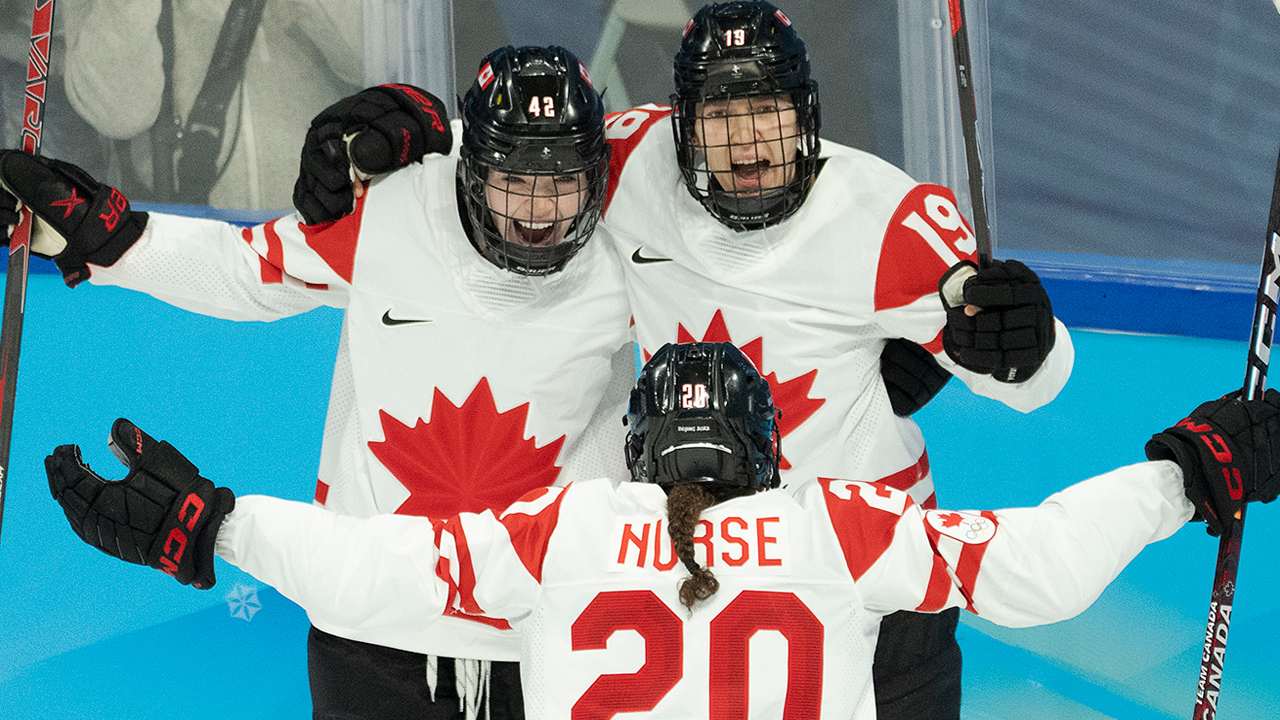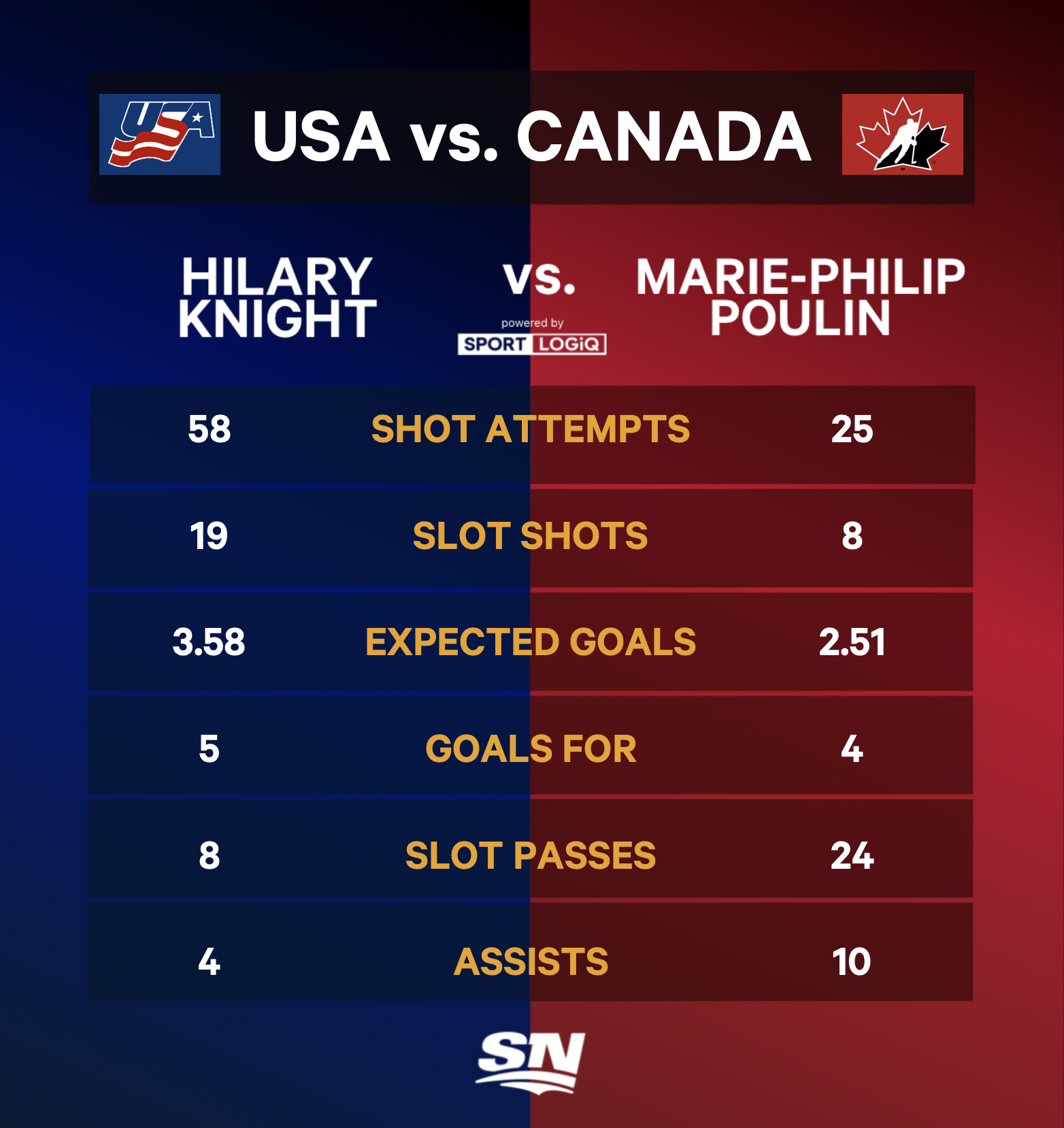
The moment many of us have been thinking about since 2018 is here: a rematch of two powerhouses for Olympic gold between USA and Canada.
We all know what happened in 2018 (sorry, blame Sportsnet for allowing an American to write this!) — Team USA was victorious in the shootout, claiming gold over Canada after Jocelyne Lamoureux-Davidson’s iconic ‘Oops, I did it again’ goal in Round 6 and Maddie Rooney’s stop against Meghan Agosta.
Now, four years later, they’re matching back up with one team looking to repeat, and the other striving to get back on top.
How to watch Canada go for gold
With a gold medal on the line, the next chapter in the storied rivalry between the Canadian and American women’s hockey teams will be written on the Olympic stage. Here’s how to watch the game on Sportsnet.
If you’re thinking this matchup was inevitable, you’d probably be right — and not because it’s a two-team tournament. Every federation should be looking to USA and Canada as the gold standard of what women’s hockey can be with the right investment. And many have been taking notes and improving over the past four years. But just as other teams — like Czechia, Denmark, Japan, and even Sweden after fighting to get support — have grown, so have USA and Canada to get back to this very moment.
So let’s break this matchup down by the numbers.
Starting with the challenger, Canada has gone 6-0-0 this tournament. Along with piling up the wins, they’ve also been pouring on offence.
In all situations, Canada has averaged 76.6 shot attempts per game, with about 45 connecting on goal. These aren’t just perimeter shots either, with 27.8 coming from the slot to boost their expected goal generation up to 5.54 per game, on average. Thanks to some top notch finishing talent up and down their lineup, they’ve averaged nine goals per game.
Any over-performance like that begs the question of sustainability. In a tournament setting, though, that may not be a concern. Especially not when this lineup is loaded with so many different contributors to that scoring.
On the other end of the ice, Canada doesn’t allow nearly as much as they create. On average, their opponents have generated just 36.5 shot attempts against, and only 17.5 actually reach the net. They keep opponents out of the slot area often, with just 7.2 shots incoming from there, per game. The offence they do concede generally comes off the cycle, as they limit most rush chances and rebounds against.
Whatever gets through Canada’s defence goes up against Ann-Renée Desbiens in net; she’s rocking a .920 save percentage through four games where she’s saved .25 goals above expected.
As for the reigning champions, USA has gone 5-1-0 this tournament.
They lead all teams in shot volume, with 91.2 attempts on average, and 49.5 shots on goal. Where they rank below their opponent to the north, and second overall in the Games, is quality with 27.5 slot shots and a total expected goal value of 4.95.
In their own end, USA has been quite stingy, holding their opponents to just 29.8 shot attempts, on average, and 5.5 slot shots. Thanks to their shot and scoring chance suppression, they’ve allowed just 1.12 expected goals against on average — but conceded 1.33 goals.
Goaltending was the story for USA going into the tournament, because it wasn’t clear who the starter would be. After rotating all three goalies — Maddie Rooney, Nicole Hensley, and Alex Cavallini — the latter eventually earned the starting role. Rooney was the first to get her second start, and it was against Canada making it a potential indication that she could own the crease moving forward. But after allowing 2.82 more goals than expected through two games, Cavallini took over — she’s saved 95 per cent of the shots turned her way and 1.65 more goals than expected in three tilts.

The one loss on USA’s record came against Canada to close out the preliminary round. USA generated more offence, and forced their opponent to concede more shots than ever in the Games. They just couldn’t finish and lost the special teams battle. USA’s power play falling short has been a theme of the tournament, while Canada’s clicking with their’s and the power kill, making it even more of an uphill battle for their opponent.
With this matchup comes a showdown of two of the best in hockey once again: Marie-Phillip Poulin and Hilary Knight.
Poulin may have started slower on the scoresheet than some of her teammates, but is now up to four goals and 14 points in six games that ties her for second on the team.
She doesn’t lead in shot volume, but is efficient with her shots; 68 per cent of her attempts have reached the net and eight have come from the slot. When she isn’t shooting, she’s setting up her teammates as one of the ultimate dual-threats on the ice — Poulin leads the tournament with 24 passes to the slot.
That said, last time these teams met, it was her shot that was on display with five attempts and a goal. Captain Clutch is known for big time goals, especially against USA.
On the other side of the matchup is Knight, who leads the way for USA with five goals and nine points. No one has shot the puck more than the winger’s 58 attempts in all situations, 19 of which have come from the slot. The majority of her chances have come off the cycle, though she’s chipped in rushes as well. Few players are better at driving to the high danger areas of the ice, or scoring from there, which is why she’s one of the best Americans to play at this level.

Aside from Poulin, USA’s going to have their hands full keeping Canada’s skaters off the scoresheet. All three members of that top line — Poulin, Sarah Nurse, and Brianna Jenner — have been dangerous. Even if USA matches up their best, Lee Stecklein, against them, they can’t overlook the second trio of Emily Clark-Blayre Turnbull-Rebecca Johnston. After them, there’s still the Sarah Fillier line to watch.
Fillier’s been one of the most dynamic players this tournament, scoring eight goals and 11 points along the way. She’s one of the best at generating shots (42 attempts) and quality chances (18 slot shots, 3.22 xG for). Then there’s her finishing ability to factor in. That’s another line combination where all three members are dangerous, whether it’s Mélodie Daoust or Jamie Lee Rattray skating opposite Natalie Spooner.
Scoring isn’t limited to Canada’s forwards. Erin Ambrose, a fearless shot blocker, has four goals and nine points while Claire Thompson, in fewer minutes than some of her fellow blue liners, has had a breakout performance with 12 points.
That’s not to say USA doesn’t have other scoring options. Kendall Coyne Schofield is one of their leading offensive generators even though she’s a goal behind expectations. So is Alex Carpenter after being held off the roster in 2018. But they’re without one of their best in Brianna Decker, and don’t have that same level of production from their bottom-six — nor do they trust their depth to play much, anyway.
Just look at Canada’s third line of Daoust-Fillier-Spooner versus USA’s third line of Dani Cameranesi-Kelly Pannek-Grace Zumwinkle — there’s no competition.
Coaches are expected to shorten the bench in high pressure situations. Canada likely will despite their depth because that can be the nature of these moments. But USA’s bench has been so small before even getting to this important of a game, which doesn’t bode well for rotation in it.
Canada rightfully looks like the favourite in this game. But as lopsided as their matches may have been to this point, it’s always a close game when they meet USA — just as it was in their preliminary game, past World Championships, and back in 2018. With that ending on the minds of both teams, for different reasons, the stakes are as high as ever.
Data via Sportlogiq
Canada-USA women’s gold medal game preview: How the rivals stack up
Source: Pinas Ko Mahal


0 Mga Komento